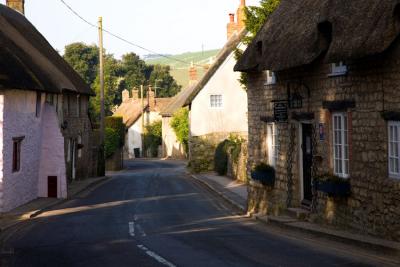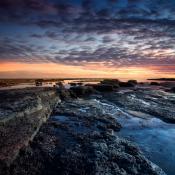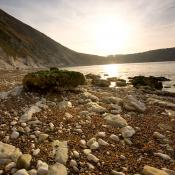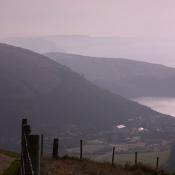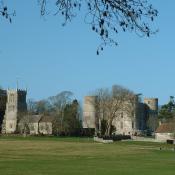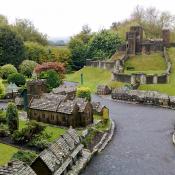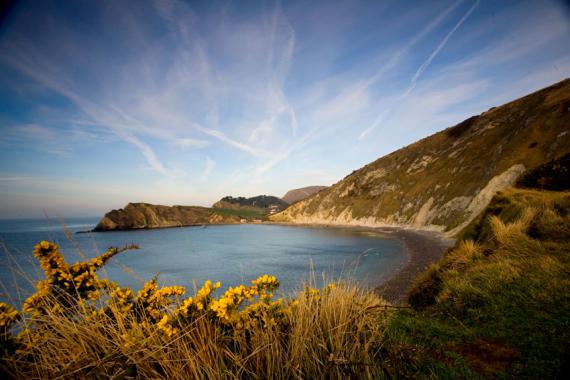
West Lulworth and Lulworth Cove
Situated between Weymouth and Swanage in south Dorset, Lulworth Cove represents one of the finest examples of a natural cove in the world. Recently incorporated into the UNESCO Jurassic Coast World Heritage Site, the area is important both for its fossils and its textbook landforms.
Like the nearby Durdle Door and Stair Hole, Lulworth Cove was formed because bands of rock of alternating resistance to erosion sit in layers parallel to the shore. The outer edge, next to the sea, is the hardest and consists of fairly resistant Portland limestone. When the sea eventually managed to break through a tiny fault in this layer of limestone it proceeded to scoop a near-perfect circle out of the soft clays and sands behind, a process of erosion that was halted at the back of the cove by a thicker band of more resistant chalk, also known as the Purbeck Hills.
The cove, which featured in a television programme called 'Seven Natural Wonders', is a working fishing cove with a beach suitable for swimming, snorkelling and diving. About half a mile north of the cove itself is the village of West Lulworth. With a population of around eight hundred, the village is a popular Jurassic Coast access point and can get very busy in high season. Dominated by Bindon Hill to the east, a 170m ridge with extensive remains of Iron Age earthworks, and Hambury Tout to the west, with a barrow on its circular top, the village is a picturesque affair and home to one of the oldest pubs in Dorset. The Castle Inn dates from the 16th century and retains original woodwork and a traditional thatched roof.
Lulworth's Fossil Forest
Just a short walk east from West Lulworth is the famous 'fossil forest' where the remains of growths that formed around tree stumps around 135 million years ago can still be clearly seen, along with the ripple marks of an ancient beach. In order to reach the forest it is necessary to pass through an army firing range that sits next to Lulworth Cove. It is worth checking firing times before planning a trip!
Durdle Door
A short walk from Lulworth Cove is Durdle Door, a striking natural arch also formed due to the erosion of bands of rock of alternating resistance that sit in layers parallel to the shore. In this case the rock strata are narrow and nearly vertical, so that nearly all the outer edge of Portland limestone has already been worn away, rather than just a small gap such as that at Lulworth Cove. The short stretch that remains now appears as the flat end of a small headland, protecting the final outpost of clay behind it and giving, from above, a distinctive 't' shape. On the western side a hole has been eroded in the limestone, forming the world famous natural arch. The sloping beach behind the headland is also great for swimming and snorkelling.
Stair Hole
To get a sense of the processes that have been acting on Lulworth Cove for all these millions of years, it is worth walking the half mile along the coast to Stair Hole, where the sea has made a small arch in the outer layer of resistant limestone and begun eroding the softer clays behind. Lulworth Cove might have looked something like this around 10 000 years ago. Stair Hole is also famous as a fantastic example of a geological phenomenon known as the 'Lulworth Crumple'. This phenomenon arose as a result of a process caused by movements in the earth's crust several million years ago and appears as if the rock has literally crumpled under pressure.
Lulworth Castle and East Lulworth
Lulworth Castle was a mock castle/hunting lodge built in the early 17th century by Thomas Howard, 3rd Lord Bindon of the nearby Bindon Abbey and son of the Duke of Norfolk. The extensive Howard clan were very popular at the court of James I and the design for the castle is thought to have been inspired by the particular type of Chivalric literature so beloved by it. Like many of Dorset's most famous old manors, both Blindon Abbey and Lulworth Castle were badly damaged during the civil war, and in 1641 the estate was sold to a wealthy Londoner called Humphrey Weld.
The Estate and Castle remain in the Weld family to this day, although the castle itself was gutted by a fire in 1929 and remained a roofless ruin until English Heritage stepped in to help restore it in the 1970s, a process that is far from complete. Still owned by the Weld family the estate is run as a tourist attraction and plays host to a number of events, most recently the award-winning Camp Bestival, a 10,000 capacity event with the likes of Chuck Berry and Kate Nash on the line up.
East Lulworth village, a little inland from its western counterpart, grew up around the church until the 18th century when it was demolished to make way for the park. While the church remained inside the park walls the houses were rebuilt outside and remain there to this day, giving the small village an old-fashioned, partly-thatched, picturesque atmosphere.Aalthough the earliest part of the church, the unusually large west tower, is made from Purbeck stone, most of the present structure dates from the 1860s when the nave and chancel were rebuilt to plans drawn up by Thomas Hardy.
In 1770 the village pub was run by Richard Champ, a smuggler operating with a well-known gang from Osmington Mills. Smuggling played an important role in Lulworth's history and the coastguard cottages in West Lulworth were built to house customs officials as part of a vain attempt to call a halt to this popular illegal activity.

